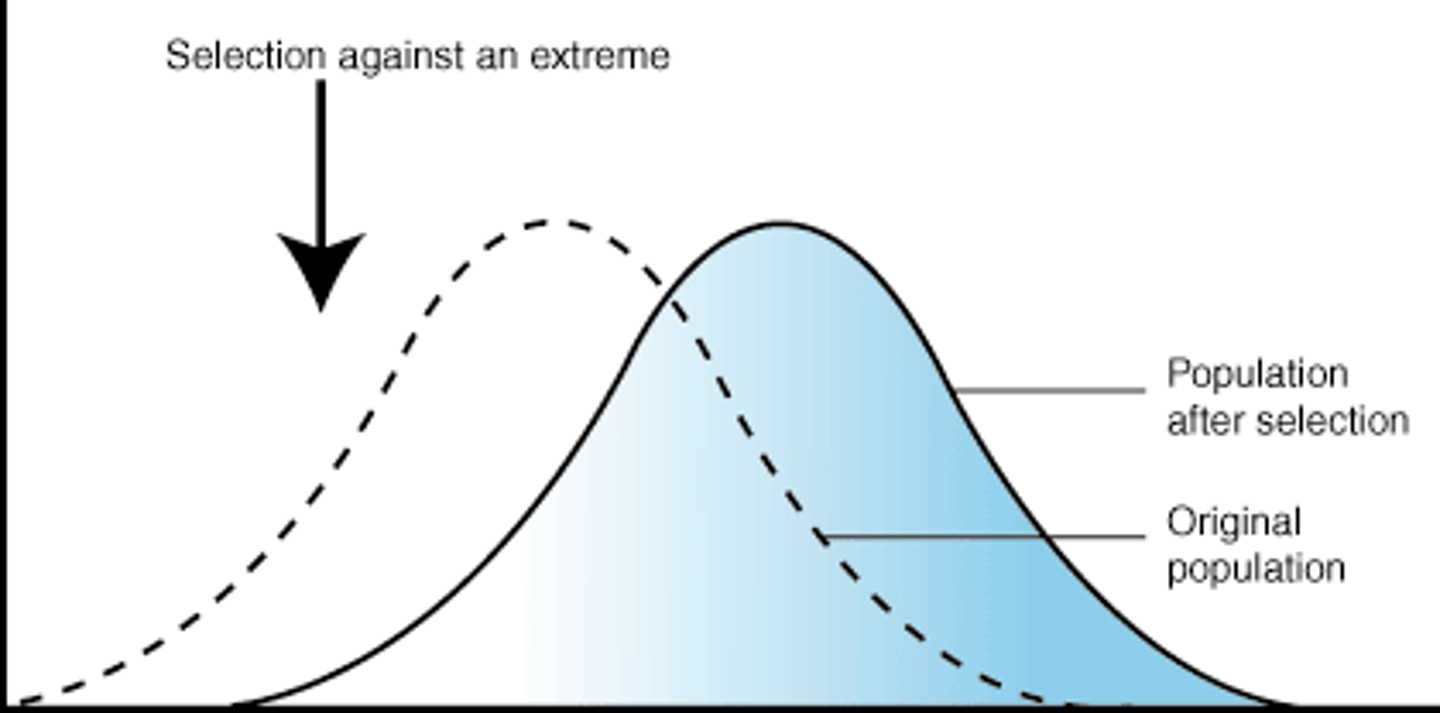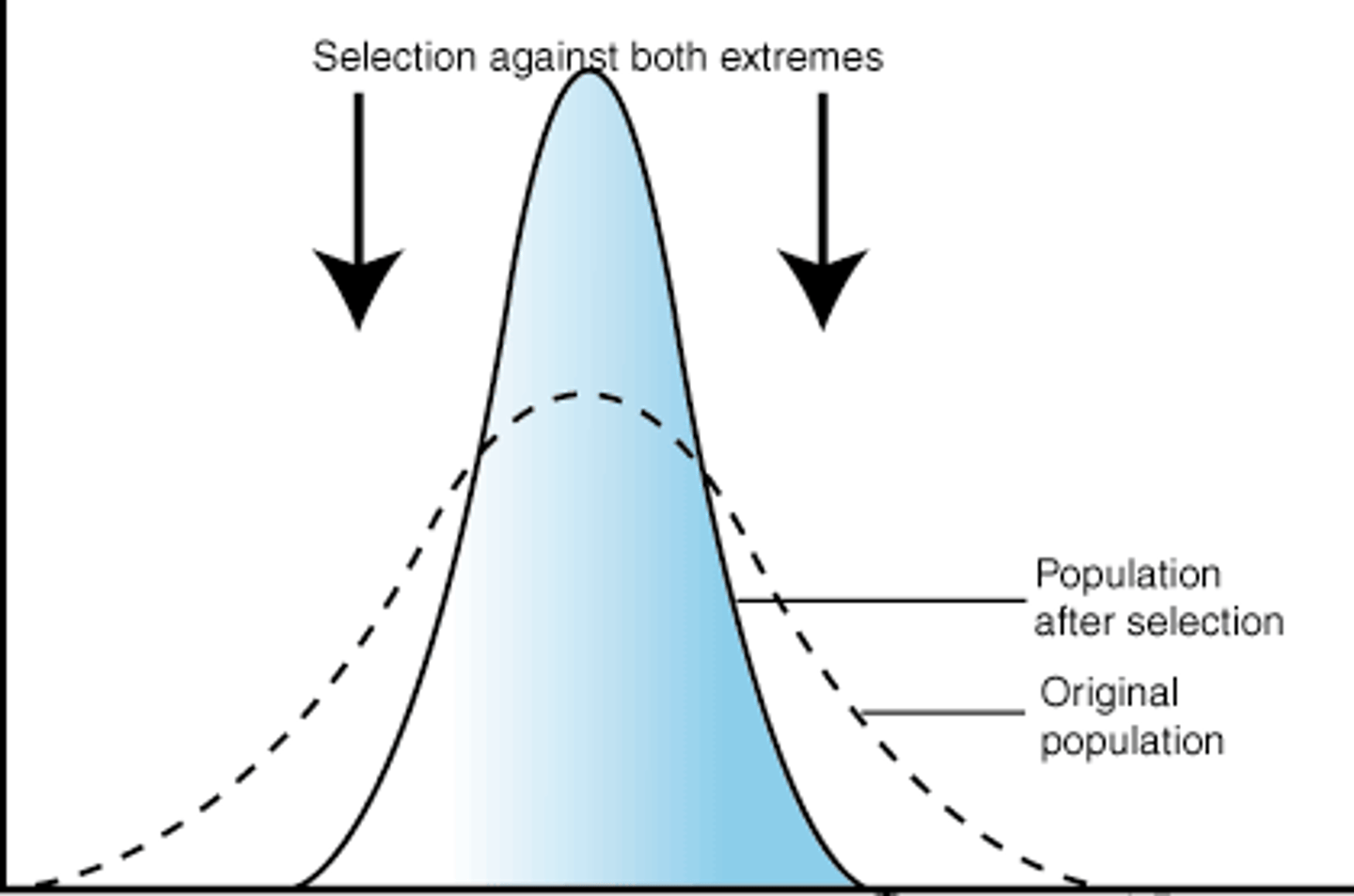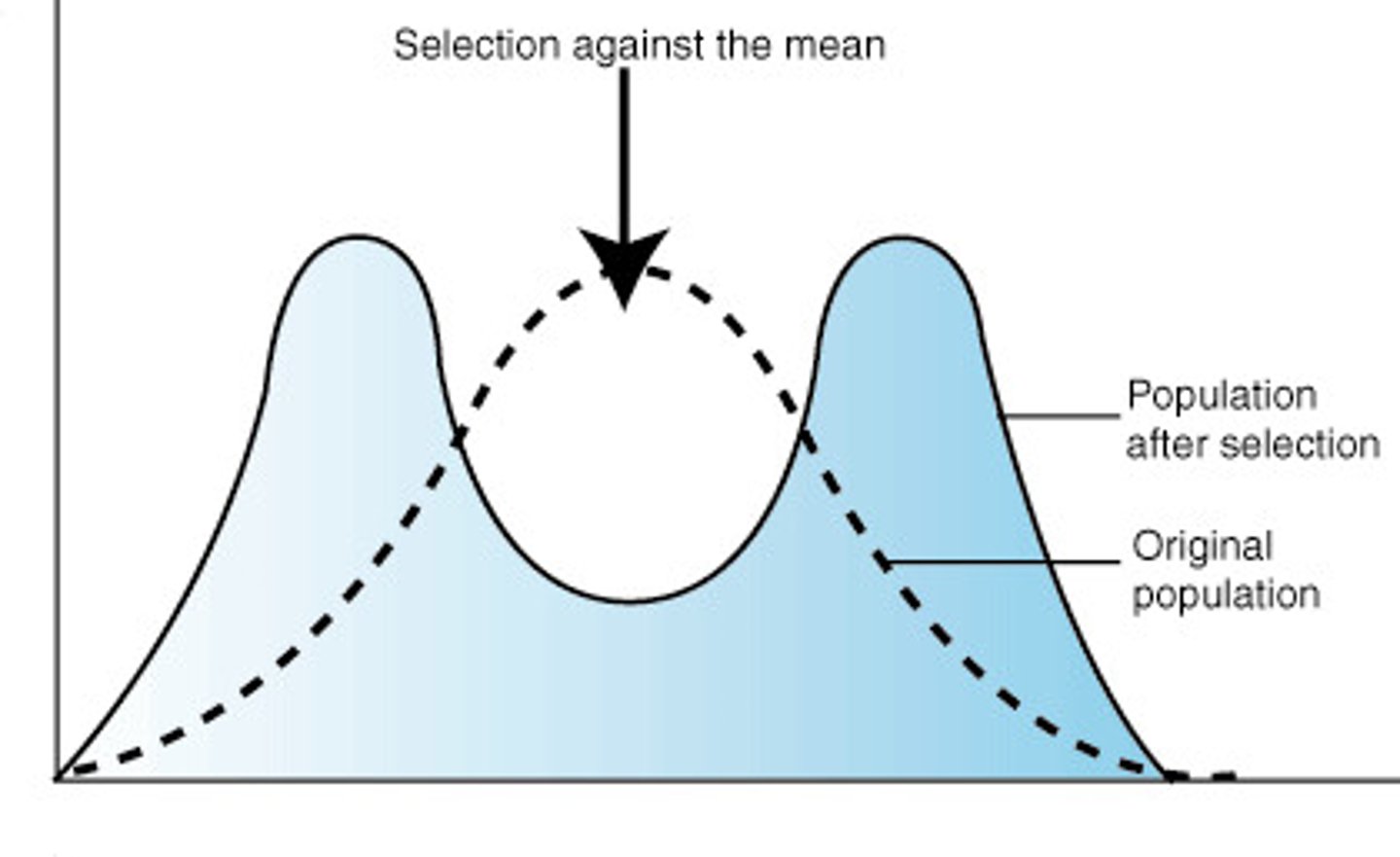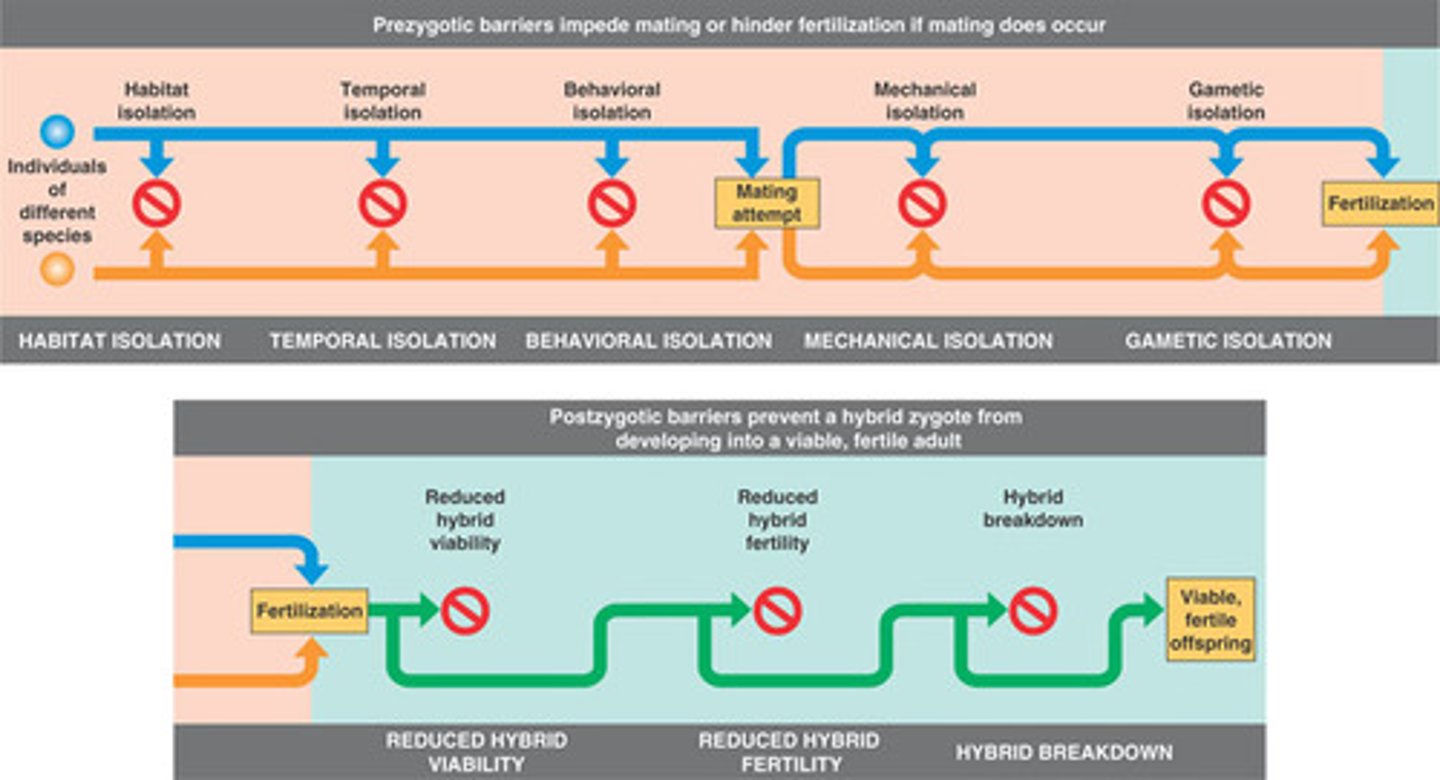WVU Biology 117 Final Exam
1/99
There's no tags or description
Looks like no tags are added yet.
Name | Mastery | Learn | Test | Matching | Spaced |
|---|
No study sessions yet.
100 Terms
Evolution
change in the gene pool of a population over time
Population
All the organisms of a particular species living in the same place at the same time
Gene Pool
All the alleles of all the genes in a species or population
Natural Selection
Differential reproduction based on heritable traits
Biological fitness
The ability of an individual to produce surviving, fertile offspring relative to that ability in other individuals in the population
Facts of Natural selection
- requires varied population
-does not create new traits or alleles
-mutations do not occur to solve problems
-adaptations do not occur because organisms want or need them
-evolution is not progressive
-nat. sel. does not change an organism over its lifetime
-does not make perfect organisms
-A fitness trade-off is a compromise between traits in terms of how those traits perform in the environment
Fossil Record
-imprints or remains of organisms that lived in the past
-reveals the appearance (and disappearance) of organisms in a historical sequence
Biogeography
-the study of the geographic distribution of species that first suggested to Darwin that today's organisms evolved from ancestral
-species in the same area tend to be more closely related to one another
-must also consider Continental Drift
Homologous structures
-comparative anatomy reveals this
-similarity due to shared ancestry
-different functions, different shape on outside, BUT similar bones inside
Vestigial traits
similar in structure but no longer functional
Comparative Embryology
early stages of development are very similar
-developmental homology
-embryos of vertebrates begin similarly but then develop differently
Molecular biology
studies look to DNA, RNA, and proteins for differences and similarities between organisms to determine how long they may have shared a common ancestor
Anatomy
the study of an organism's physical structure
Physiology
the study of how the physical structures in an organism function
Five causes of Evolution
1. Genetic Drift
a. Bottleneck
b. Founder Effect
2. Gene Flow
3. Mutation
4. Natural Selection
5. Nonrandom mating (including
sexual selection)
Genetic Drift
- any change in allele frequencies in a population due to chance
- random with respect to fitness
>especially prevalent in small
populations
Two cases of Genetic Drift
- Founder Effect
-Bottleneck Event
Bottleneck Event
sharp reduction in the size of a population due to environmental events (such as earthquakes, floods, fires, disease, or droughts) or human activities (such as genocide)
Founder Effect
when a new colony is founded by a small number of individuals
-Example: Deafness in Martha's
vineyard
>37 to 230 times more
common than rest of US
Gene flow
-genetic exchange with another population
-Immigration
-Emigration
-Examples: Human movement/colonization
Mutation
the changing of the structure of a gene, resulting in a variant form that may be transmitted to subsequent generations, caused by the alteration of single base units in DNA, or the deletion, insertion, or rearrangement of larger sections of genes or chromosomes
Missense mutation
(may not need to know)
This type of mutation is a change in one DNA base pair that results in the substitution of one amino acid for another in the protein made by a gene.
Nonsense mutation
(may not need to know)
A nonsense mutation is also a change in one DNA base pair. Instead of substituting one amino acid for another, however, the altered DNA sequence prematurely signals the cell to stop building a protein. This type of mutation results in a shortened protein that may function improperly or not at all
Insertion mutation
(may not need to know)
An insertion changes the number of DNA bases in a gene by adding a piece of DNA. As a result, the protein made by the gene may not function properly
Deletion mutation
(may not need to know)
A deletion changes the number of DNA bases by removing a piece of DNA. Small deletions may remove one or a few base pairs within a gene, while larger deletions can remove an entire gene or several neighboring genes. The deleted DNA may alter the function of the resulting protein(s)
Frameshift mutation
(may not need to know)
This type of mutation occurs when the addition or loss of DNA bases changes a gene's reading frame. A reading frame consists of groups of 3 bases that each code for one amino acid. A frameshift mutation shifts the grouping of these bases and changes the code for amino acids. The resulting protein is usually nonfunctional. Insertions, deletions, and duplications can all be frameshift mutations
Nonrandom mating
-inbreeding/outbreeding
-sexual selection (choosing your mates)
Natural selection
differential survival and reproduction based off of heritable genetic traits
Four modes of natural selection
-Directional selection
-Stabilizing selection
-Disruptive selection
-Balancing selection
Directional selection (Oscillating)
-changes the average phenotype in the population in one direction
-tends to reduce the genetic diversity of populations

Stabilizing Selection
-reduces both extremes in a population
-reduces genetic variation in a trait but does not change the average value of the trait over time

Disruptive Selection
-intermediate phenotypes are selected against and extreme phenotypes are favored
-Increases variation in a trait

Balancing Selection
-no single allele has a distinct advantage
>there is a balance amongst
several alleles in terms of
fitness and frequency
-Occurs when:
1. Heterozygous individuals have higher fitness than homozygous individuals do---heterzygote advantage
2. Certain alleles are favored at different times or in different places
3. Certain alleles are favored when they are rare but not when they are common (Frequency-dependent selection)
Selection in sickle cell anemia
-Single nucleotide substitution in hemoglobin protein
Genotype
AA; No sickle cell anemia,
susceptible to malaria
Aa; No/mild symptoms sickle cell
anemia and for susceptibility to
malaria
aa; Yes sickle cell anemia, No
susceptible to malaria
Evolution
A change in the gene pool of a population over time
-If traits are changing, then the alleles in a pop. are changing
soooooo
Evolution--> change in the allele frequencies of a pop. over time
5 Assumptions of the Hardy-Weinberg Principle
1. Random mating- no mate choice; gametes combine randomly
2. No natural selection- all individuals contribute equally to gene pool
3. No genetic drift- alleles not picked by chance because population is large
4. No gene flow- no new alleles added or lost from gene pool
5. No mutation- no new alleles introduced into gene pool
Deriving Hardy-Weinberg Principle
-Started with simplest situation, a gene with two alleles A1 and A2
-Frequency of A1 is represented by p and frequency of A2 is represented by q in the gene pool
- p+q=1
-Three possible genotypes: A1A1, A1A2, and A2A2
-Frequency of A1A1 genotype is p^2
-Frequency of A2A2 genotype is q^2
-Frequency of A1A2 genotype in 2pq
- p^2+2pq+q^2=1 (H-W Equation)
Calculations for H-W
-Observed genotypic frequencies (OGF)
> Divide # of individuals with each genotype by total # of individuals in sample
-Allele frequencies
>find frequency of p and q(A1 and A2 allele) for example p would be OGF for p^2 + half OGF 2pq
-Expected genotypic frequencies
> take allele frequencies and do what equation says for example take allele frequency for p and square it to get the expected (p^2)
G-Test Statistic
G= 2 Σ O* ln(O/E)
null hypothesis- Pop. is H-W Equilibrium
Chi-Square table (χ^2)
-Provides the value to which we compare the G-stat to determine if the null hypothesis is supported or not
-α= 0.05 (5% chance reject hypothesis when hypothesis is true)
Two Factors for New Species to Form
1. Genetic isolation between populations
2. Genetic divergence (deviation/change)
Two main types of speciation events
1. Allopatric Speciation
-Genetic isolation due to geographic separation
2. Sympatric Speciation
-Genetic isolation without geographic separation
Allopatric Speciation
-Genetic isolation due to geographic separation
-Two types:
1. Dispersal
2. Vicariance
-Allopatric events do not guarantee speciation will occur
Allopatric- Dispersal
across a preexisting geographical barrier (for example, a mountain chain)
Allopatric- Vicariance
the fragmentation of a widespread ancestral distribution by the appearance of a new barrier
Sympatric Speciation
-Genetic isolation without geographic speciation
-Two main causes:
1. Behavior change
2. Genetics/ploidy level
Sympatric Speciation: due to behavior
Examples: things like different mating preferences
Sympatric Speciation: due to ploidy
-can be due to errors in meiosis
-more likely in plants
>leads to diploid eggs and
sperm
-Isolation may not be instantaneous
Sympatric Speciation: Autopolyploidy
-Auto = self
-common in self-fertilizing plants
-Example: apples
Sympatric Speciation: Allopolyploidy
-Allo = different
-Common occurrence in plants
Speciation and Genetic Divergence
After genetic isolation, when does genetic divergence become enough to call the two isolated populations different species
Species
-an evolutionary independent population or group of populations
-Biologists commonly use three criteria for identifying species:
1. Biological Species Concept
2. Morphospecies Concept
3. Phylogenetic Species Concept
*Each species concept has its limitations
Biological Species Concept
-Naturally occurring groups of organisms that:
>Interbreed in nature
>Produce viable and fertile offspring
>Cannot produce viable and fertile offspring with members of other species
-Disadvantages:
>Reproductive isolation cannot be evaluated in: Fossils, species that reproduce asexually, or closely related populations that are isolated from one another
Mechanisms of Reproductive Isolation
2 Categories of barriers:
-Prezygotic
-Postzygotic

Pre-zygotic barriers
1. Temporal Isolation
2. Habitat Isolation
3. Behavioral Isolation
4. Mechanical Isolation
5. Gametic Isolation
Temporal Isolation
when different species reproduce at different times
Habitat Isolation
the species remain isolated because they breed in different habitats
Behavioral Isolation
the species have differences in mating rituals
Mechanical Isolation
the species are physically unable to reproduce
Gametic Isolation
reproduction is prevented because gametes are not compatible with each other
Post-zygotic barriers
1. Reduced Hybrid Viability
2. Reduced Hybrid Fertility
3. Hybrid Breakdown
Reduced Hybrid Viability
hybrids do not develop fully or die at a young age
Reduced Hybrid Fertility
hybrids cannot reproduce because they are sterile
Hybrid Breakdown
the first-generation hybrids are viable and fertile, but when they mate the offspring are feeble and sterile
Morphospecies Concept
-Based on morphological features
-Widely applicable
-Disadvantages:
>Subjective
>Polymorphic species
>Cryptic species
Phylogenetic Species Concept
-Based on evolutionary history
-Disadvantages:
>Limited Data, many more species?
Phylogeny
Evolutionary history of a group of organisms
Phylogenetic tree
-graphical summary of this history
-shows evolutionary relationships among genes, species, and higher taxa
-Branch represents a population through time
-Node represents a divergence; ancestral species split into two or more decendant species
-Tip represents a group (species or other larger taxon)
-Root is the most ancestral branch in the tree
-Sister taxon---the closest relatives of a given taxon
-Polytomy is a node that divides into 3 or more branches suggesting that not enough data was available to resolve which taxa are most closely related
Ancestral Traits
a characteristic that existed in an ancestor
Derived traits
a characteristic that is a modified form of the ancestral trait, found in a descendant
Cladistics
-phylogenetic trees built with shared, derived traits (synapomorphies)
-Shared, derived traits used to identify monophyletic groups(clades)
Analogous traits
similarities due to convergent evolution
Monophyletic group
includes ancestral population and all of its descendants but no others
Paraphyletic group
includes ancestral population and some of its descendants but not all
Polyphyletic group
-unnatural group
-does not include most recent common ancestor
Parsimony
-principle of logic
-states that the most likely explanation or pattern is the one that implies the least amount of change
-fewer ticks more parsimonious
HIV-1
-virus that can lead to Acquired Immune Deficiency Syndrome (AIDS)
-Retrovirus
>Uses reverse transcriptase to produce DNA from RNA
Reverse Transcriptase
-"Error Prone" enzyme
-Mutation rates are extremely high
>multiple "families" of HIV viruses even within one individual because of this you can not link the strain directly to its source
Bacteria and Archaea
-distinguished by
>types of molecules that make up plasma membranes and cell walls
>machinery they use to transcribe DNA and translate mRNA into proteins
5 Things studied in Bacteria and Archaea
1. Biological Impact
2. Habitat Diversity
>Extremophiles
3. Medical Importance
> Pathogens
4. Role in bioremediation
5. Foods
Biological Impact
-Ancient and diverse lineages
>Oldest fossils are of 3.5-billion-year-old bacteria
>Hundreds of thousands likely exist
-Microbiome is the community of microbes that naturally inhabit the body or parts of the body
Habitat Diversity
-Live almost everywhere
-Extremophiles live in extreme habitats
Medical Importance
-pathogens are bacteria that cause illnesses
Bioremediation
-used to clean up sites polluted with organic solvents
-naturally existing populations can grow in spills and degrade toxins
Food
present in lots of food
Themes that occur in diversification of bacteria and archaea
-Genetic variation through gene transfer
-Morphological diversity
-metabolic diversity
-ecological diversity and global impacts
Gene Exchange (B&A)
-do not undergo sexual reproduction, instead swap genes
-3 mechanism of horizontal gene transfer:
Transformation
DNA from environment is taken in and used
Conjugation
direct contact and DNA sharing between cells
-pili structure---tunnel connection
Transduction
viruses pick up DNA from one cell and transfer it to another cell
Diplo-
Strepto-
Staphylo-
straight line, circular
line, rectangular
random placement, circular
Gram Staining
stain attaches to peptidoglycan in cell wall
-Gram-Positive
-Gram-Negative
ATP Production (energy source): phototrophs
light used to excite electrons
-atp made by phosphorylation
ATP Production (energy source): chemoorganotrophs
oxidize organic molecules with high potential energy
-atp made by cellular respiration or fermentation pathways
ATP Production (energy source): chemolithotrophs
oxidize inorganic molecules with high potential energy
-atp made by cellular respiration
Carbon source: autotrophs
build compounds from simple material
Carbon source: heterotrophs
absorb compounds from environment
Protists are considered to be...
-fungus-like
animal-like
-plant-like
Endosymbiosis theory
-mitochondria originated when a bacterial cell took up residence inside another cell about 2 billion years ago
Secondary Emdosymbiosis
eukaryotic chloroplast originated when a protist engulfed a cyanobacterium